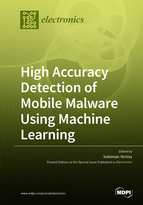High Accuracy Detection of Mobile Malware Using Machine Learning
A special issue of Electronics (ISSN 2079-9292). This special issue belongs to the section "Networks".
Deadline for manuscript submissions: closed (31 October 2022) | Viewed by 52204
Special Issue Editor
Interests: malware analysis and detection; applied machine learning; mobile security; transparent authentication; IoT security; intrusion detection systems
Special Issue Information
Dear Colleagues,
Smartphones have become pervasive in modern life, thus leading to mobile operating systems such as Android and iOS becoming increasingly targeted by malicious software (malware). Mobile malware has witnessed an explosive growth in the past few years. In 2019, a leading anti-malware vendor reported that over six million new mobile malware samples were discovered in the previous year. With such an increase in mobile malware, the limits of traditional signature-based antivirus scanning have been stretched. This has led to the emergence of machine-learning-based detection as a complementary solution to traditional antivirus scanning. Although machine-learning-based mobile malware detection has continued to attract great research interest, many challenges remain as emerging mobile malware families continue to exhibit more sophisticated capabilities and stealthy evasive techniques.
This Special Issue calls for contributions that focus on novel, efficient and high-accuracy detection of malware on the mobile platform using machine learning. The Special Issue invites authors to submit high-quality research papers reporting the latest results and innovative approaches featuring robust, scalable, obfuscation-resilient, attack-resistant machine learning techniques. The scope of the topics for this Special Issue includes (but is not limited to) the following:
- Systematic review of the latest machine-learning-based mobile malware research
- Novel machine learning techniques applied to mobile malware
- Deep-learning-based detection of mobile malware
- Novel supervised and unsupervised learning techniques
- Classifier fusion and ensemble-learning-based approaches
- Novel system architectures for mobile malware detection
- Network-based machine-learning-driven detection systems
- Edge/fog computing machine-learning-based detection systems
- Cloud-based/cloud-assisted large-scale detection systems
- Adversarial machine learning techniques
- Mitigating long-term performance decline
Dr. Suleiman Yerima
Guest Editor
Manuscript Submission Information
Manuscripts should be submitted online at www.mdpi.com by registering and logging in to this website. Once you are registered, click here to go to the submission form. Manuscripts can be submitted until the deadline. All submissions that pass pre-check are peer-reviewed. Accepted papers will be published continuously in the journal (as soon as accepted) and will be listed together on the special issue website. Research articles, review articles as well as short communications are invited. For planned papers, a title and short abstract (about 100 words) can be sent to the Editorial Office for announcement on this website.
Submitted manuscripts should not have been published previously, nor be under consideration for publication elsewhere (except conference proceedings papers). All manuscripts are thoroughly refereed through a single-blind peer-review process. A guide for authors and other relevant information for submission of manuscripts is available on the Instructions for Authors page. Electronics is an international peer-reviewed open access semimonthly journal published by MDPI.
Please visit the Instructions for Authors page before submitting a manuscript. The Article Processing Charge (APC) for publication in this open access journal is 2400 CHF (Swiss Francs). Submitted papers should be well formatted and use good English. Authors may use MDPI's English editing service prior to publication or during author revisions.
Keywords
- Systematic review of the latest machine-learning-based mobile malware research
- Novel machine learning techniques applied to mobile malware
- Deep-learning-based detection of mobile malware
- Novel supervised and unsupervised learning techniques
- Classifier fusion and ensemble-learning-based approaches
- Novel system architectures for mobile malware detection
- Network-based machine-learning-driven detection systems
- Edge/fog computing machine-learning-based detection systems
- Cloud-based/cloud-assisted large-scale detection systems
- Adversarial machine learning techniques
- Mitigating long-term performance decline






